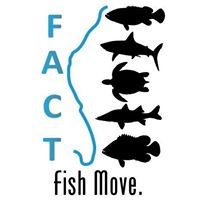So what’s the deal with your name? You’re called the Florida Atlantic Coast Telemetry Network but have members working in Georgia, South Carolina, the Bahamas, and Caribbean.
Our name is just an artifact of how our group has grown. While some of our earliest tracking studies began on the Florida east coast, many species we study are highly migratory (including some we thought didn’t move much) so coordination and data sharing with researchers over a wider region has become invaluable. All FACT members are co-equals and many also partner with the Atlantic Cooperative Telemetry Network to our north and the iTAG network in the northern Gulf of Mexico. We’ve kept our original name for consistently (and the acronym appeals to our scientific nature) but we may change it in the future to better represent all our members.
What is the relationship between the FACT Network and SECOORA?
SECOORA is our regional arm of the Integrated Ocean Observation System (IOOS) and has a mandate to coordinate and disseminate marine data and forecasts for defense, commerce, and navigational purposes. While the FACT Network is an independent research group, our products can be valuable to SECOORA customers. As such, SECOORA has graciously offered to host and help develop the FACT Network website.
Why is acoustic telemetry the centerpiece technology of the FACT Array?
Our researchers often use more than one tagging technique for assessing animal behavior but acoustic telemetry has advantages over other methods. For example, it provides much more movement detail than traditional external tagging studies which rely on physical recapture of a marked animal. It also works much better in salt water than radio telemetry, and often costs less, and be used on smaller species than bulky satellite transmitters. Its main limitation is that our transmitters must be in range of acoustic receivers to be detected. This is why our efforts to coordinate receiver locations and share detection data are so important.
What is the difference between active and passive acoustic telemetry?
Active telemetry generally refers to the technique of continuously following a tagged animal through its environment, typically by a (sleep-deprived) researcher with a portable receiver in a boat. This approach provides highly detailed estimates of animal movement and habitat use but for short (~1-3 day) periods. Passive (or autonomous) acoustic telemetry uses transmitters that ping less frequently but have a much longer battery life, and are detected by submerged stationary receivers. This strategy allows researchers to answer new questions regarding seasonal habitat preferences, coastal migrations, and survival. And sleep in a little longer.
What receiver brand is the FACT Network based on?
Our researchers primarily use Vemco acoustic receivers and transmitters.
Can your fish and sea turtles hear the transmitters?
Our transmitter frequency (typically 69 kHz) is well above the hearing range of most fish and sea turtle species – and humans as well. Transmitters can be heard by many marine mammals that are in the vicinity of a transmitter. But our tags briefly “ping” once every 2-3 minutes on average and there is no evidence they are detrimental to marine life.
I’m an acoustic telemetry researcher but not a FACT member. How can I tell if FACT detected my tagged animals?
Members in the FACT Network use an online system that matches detections to tags across the FACT, ACT-MATOS, Migramar, ATAP and OTN Networks. All efforts are made to identify tag owners, even if they are outside the networks. If you think your tags might have been detected by receivers in the FACT Network, please email data@thefactnetwork.org.
What do I do if I harvest a fish with a transmitter inside it?
Surprise! Anglers occasionally discover acoustic transmitters inside fish they’ve harvested. If you find a transmitter lacking researcher contact information, email the manufacturer printed on the tag (for example support@vemco.com) and provide them with the ID code printed on the tag. The more information you can provide on the animal the better! We would love to hear where you caught it (don’t worry we won’t share your secret fishing spots), any measurements you took, and photos! The manufacturer should then reach out to the researcher. Transmitters are expensive enough that they are sometimes reused where possible, and many researchers offer rewards. Because extra tags gives us extra excuses to go fishing!
